When asked which contact lens type generally provides the patient with the best vision, contact lens practitioners of a certain age will likely respond that this has to be a rigid lens of some type. Similarly, when presented with an uncomplicated low myope with a 1.00DC cylinder, many of those who, like the authors, were fitting in the eighties and early nineties, would most likely have discussed the superior visual performance of an RGP as the simplest and most effective way to correct the patient’s astigmatism. Younger readers need to appreciate that ‘back in the day’ there were no disposable lenses and torics were still largely lathe-cut and not made with the accuracy and reproducibility of today’s products.
Additionally, many practitioners, when presented with a patient seeing 6/5 on the chart but complaining they were still aware of their RGP lenses, would likely have mused, ‘if only there was a lens that could give me the visual performance of an RGP combined with the comfort of a soft lens’. A best of both worlds hybrid type lens with an RGP centre and a hydrogel skirt perhaps?
Brief History
In fact, the idea behind the hybrid contact lens is not new. The first hybrid was the Saturn II from Precision Cosmet; it was invented by Erikson and Neogi and gained FDA approval and appeared on the market in 1984. Sola Barnes Hind purchased Precision Cosmet in 1986 and released the next generation hybrid – Softperm – in 1989. Subsequently Ciba Vision, following its acquisition of Pilkington Barnes-Hind, marketed these lenses. However, a combination of poor durability, reproducibility and fitting challenges, including lens adherence, meant these lenses never became mainstream and were largely used to troubleshoot keratoconic patients with RGP tolerance issues.
It was not until early last decade that more modern designs, with new manufacturing techniques and superior bonding technologies for the junction of the RGP and soft materials, started to appear on the market. SynergEyes Inc in California was single-handedly responsible for the rebirth of the modern hybrid when in 2005 it launched SynergEyes A for the correction of myopia and hyperopia with moderate to high astigmatism and the KC, for use with irregular corneas and keratoconus. These first generation lenses proved to be very durable and popular, especially in the hospital-fitting arena, giving clear vision and superior comfort to more challenging fits. Indeed, these lenses are still widely used today. The timeline of the subsequent development of the SynergEyes range of hybrid lenses can be seen in figure 1.
 Figure 1: Evolution of SynergEyes for astigmatism, presbyopia and complex corneas
Figure 1: Evolution of SynergEyes for astigmatism, presbyopia and complex corneas
Hybrid Lens Evolution
The most recent versions of hybrids can be seen in table 1.
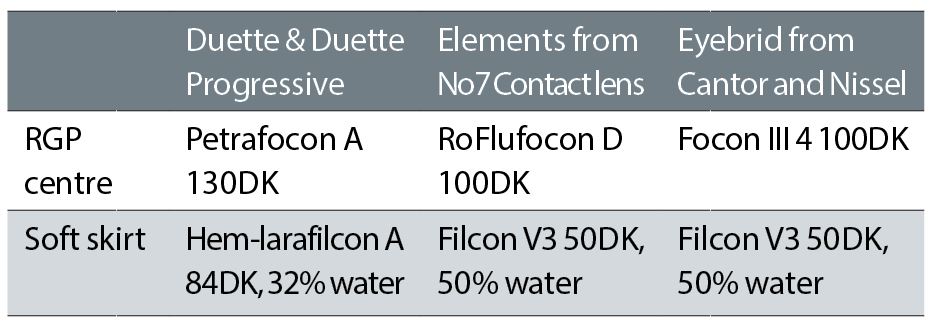 Table 1: Currently available UK hybrid lenses
Table 1: Currently available UK hybrid lenses
Figure 2 shows a typical modern hybrid design. They all use a high Dk RGP centre with a silicone hydrogel skirt of varying water content and Dk/t.
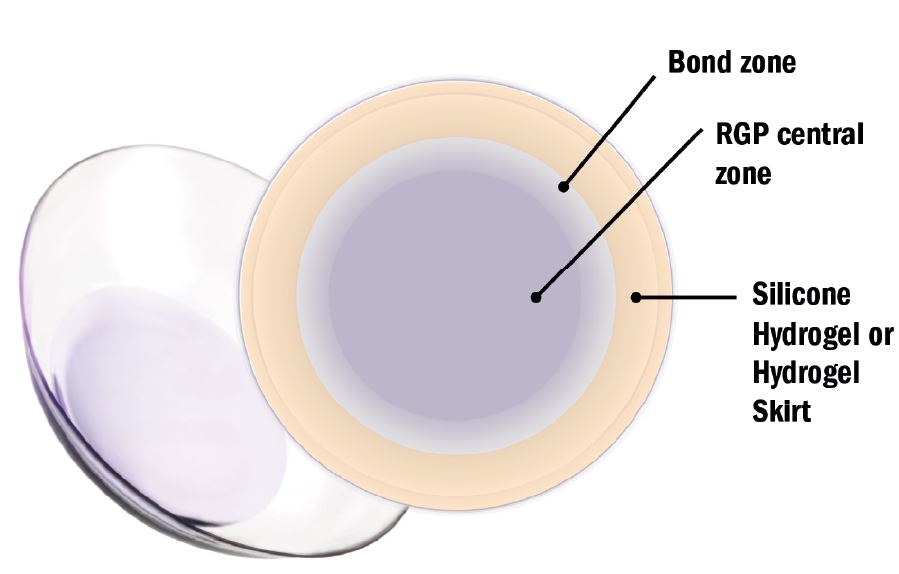 Figure 2: Modern hybrid design
Figure 2: Modern hybrid design
Broadly there are now two approaches to supply of the modern hybrids. One is the typical RGP model where by a manufacturer provides approved laboratories with buttons (in this case of the hybrid material) in order for the lab to manufacture their own designs. The other is the SynergEyes approach of developing, designing and manufacturing its own proprietary lenses more in keeping with the approach of the larger soft lens companies.
The EyeBrid Silicone hybrid (Laboratoire LCS) contact lens was introduced into the French market in 2012 and is supplied to laboratories to use either both the company’s lens design and material or just the material, in order for the laboratory to manufacture its own design. The EyeBrid Silicone hybrid is manufactured from Contamac’s Optimum 100 RGP material and its Definitive silicone hydrogel material and are used for the No7 Elements lens and the Cantor and Nissel Hybrid. The two materials are assembled using a patented process described by the company, as a ‘polymeric suture’ technology.
SynergEyes most recent lenses also use a proprietary and patented technology, where the silicone hydrogel material is covalently bonded with the GP portion of the lens. In terms of durability, a poster at this year’s BCLA Clinical Conference presented research that showed SynergEyes lenses can withstand over 10 Newtons of pressure before failure occurred, elongating the lens by 300%. Interestingly, the failure was not in the bond between the two materials but was due to the silicone hydrogel finally tearing. During the tests with an average of 8.5N there was observed a 0% failure rate.1
Hybrids in modern practice?
Broadly speaking there are two target groups for hybrid lenses – those to fit:
- Irregular corneas
- Normal (regular) corneas
It is not the remit of this article to cover the myriad of options for fitting irregular corneas. For many practitioners, these compromised corneas seem a daunting prospect and are not routinely taken on. Therefore, this CET focuses on the place for the hybrid lens on the uncomplicated eye. As previously suggested, one of the benefits of a hybrid is that it does not need a toric surface to correct corneal astigmatism of any level. It uses the tear lens optics naturally provided by the RGP central portion, that is not dependent upon lens rotation/stabilization, to correct the astigmatism. It therefore provides an alternative option for the effective correction of astigmatic patients in a regular contact lens clinic.
RGPs have decreased in popularity due to perceived complexities in fitting, initial comfort issues and the occasional irritation of environmental debris under the lenses when compared with soft lenses. Offering the quality of vision of an RGP combined with the comfort of a soft lens leads to the hybrid being a valuable option in any high street practice’s product portfolio.
Ideal Candidates for Hybrid Lenses
Ideal candidates for hybrids are low to high astigmats, presbyopic astigmats, those soft toric patients who cannot achieve the same level of clarity as with their spectacles and run the risk of dropping out (including those who have already dropped out), sports people and anyone requiring enhanced vision.
Fitting approaches
There are currently three approaches to fitting a hybrid contact lens depending on the type of cornea being fitted and the supplier of the lens (table 2).
 Table 2: Alternative hybrid fitting approaches
Table 2: Alternative hybrid fitting approaches
SynergEyes recommends the fitting of its Duette lens is carried out empirically using keratometry, subjective refraction, and horizontal visible iris diameter (HVID). This negates the need for fitting sets and the time spent using the same. Empirically fitting the Duette lens requires the following:
- Base curve: 0.10 to 0.15mm steeper than flattest K. This fitting should produce consistent centration and movement from patient to patient.
- Soft skirt: Choose the skirt curve based on corneal diameter. 11.7mm or smaller, use flat (8.40mm) skirt or 11.8mm or larger, use medium (8.10mm) skirt.
One of the benefits of empirical ordering is an improved experience for the wearer whose first experience of a hybrid, like most soft lenses, is of a comfortable lens that they can see through. This enhances the ‘wow’ factor and the patient’s confidence in the modality.
Assessing the fit
When fitting a hybrid from a rigid lens, the method of assessing the fit would be to instil sodium fluorescein (NaFl) to look at the tear pattern beneath the lens. Regular NaFl can also be used with the silicone hydrogel skirted SynergEyes lenses, however both No7 and Cantor & Nissel recommend the use high molecular weight sodium fluorescein.
Importantly, it is possible to ascertain the fit without the use of NaFl. This has a potential benefit for practitioners who started practicing during the decline of RGP fitting over the past 20 years or so. This is the approach advocated by SynergEyes for its Duette lens. The lenses are assessed initially in the same way as a soft lens, by judging the lens’ centration and movement. Then the relative alignment of the RGP is then confirmed via over-refraction. The fitting philosophy allows for a tear lens of around +0.50D (0.10mm steeper than flattest K) and so it is possible to check and adjust the fit based on the expected over-refraction.
Example:
• Rx: -2.00 / -2.00 x 95; Ks: 7.58 / 7.34; HVID: 11.7
Lens ordered: Base curve 7.50 / Skirt 8.40(Flat) Power -2.50
The over-refraction of this lens should give a plano result based upon there being a +0.50 tear lens requiring an extra -0.50D on top of the -2.00D sphere power. The alternative approaches for the assessment of hybrid fitting is summarised in table 3.

Table 3: Assessment of hybrid fit
Tear Exchange
A concern of hybrids in the past was lens adherence and compromised tear exchange along with the relatively low Dk of the materials. The ideal hybrid demonstrates a tear exchange under the lens via two modes. Firstly, upon blinking through the normal movement of a lens and, secondly, due to a ‘tear-pump’ as a result of the action of the lid/lens interaction pushing the lens in and out. The optimum relationship between a hybrid lens and the cornea/conjunctiva is illustrated in figures 3a and b.
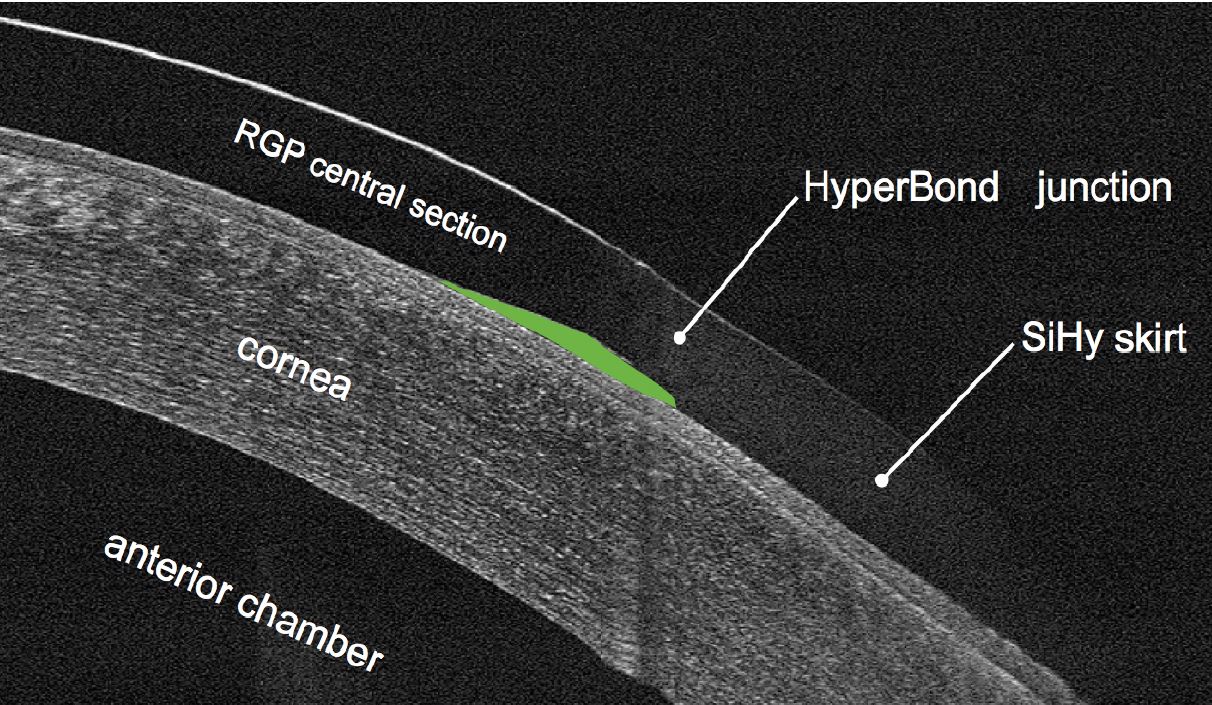
Figure 3A: OCT cross-section showing lift at the RGP/soft skirt junction of Duette lens
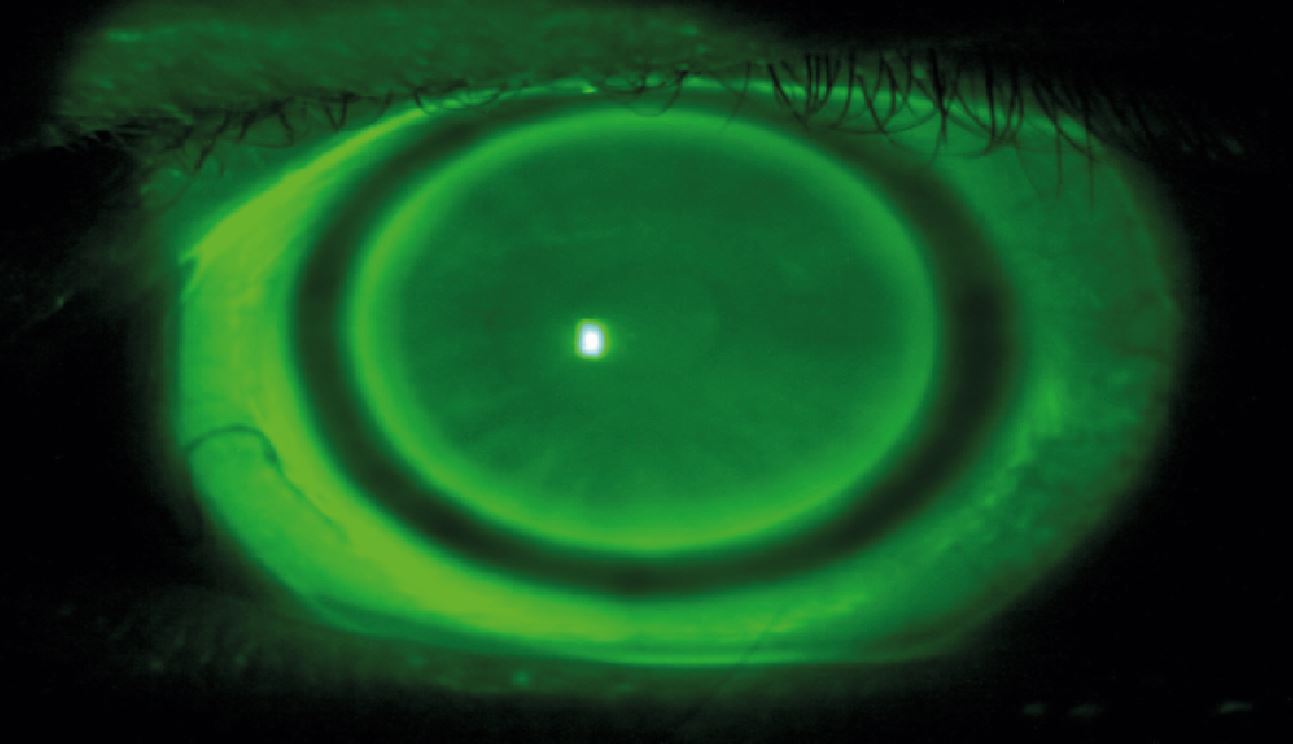
Figure 3B: Ideal Duette fit shown with NaFl. Note central thinning with lift at the junction
Therefore, the most important requirement for all hybrid lens fittings is making sure that the lens rides on a layer of tears to avoid any seal off by the soft skirt. Tight lens syndrome is a result of tears stagnating under the hybrid lens, causing toxic reaction upon the cornea. Using the same fitting philosophy as for the mild form of astigmatism, selecting the flattest skirt that does not gape will prevent tight lens syndrome. The rigid portion is fitted with an equal amount of space and compression in opposite meridians. This allows the rigid portion to rock back and forth to aid in the pumping of tears under the contact lens, allowing the lens to ride on a layer of tears.
Insertion and Removal
Insertion of a hybrid is similar to any other soft lens. It is recommended that a drop of unpreserved solution be applied to the lens before placing on the eye. Due to the more rigid nature of the lens, some people find it easier to support the lens with more than one finger and lean over the lens and place it onto the eye from below.
For removal, very dry fingers are essential. Fingers should be dried with a lint free tissue or towel. It can be beneficial to use a single ply of tissue, to cover the fingertips and provide a little more grip. Place dry fingertips at the five o’clock and seven o’clock positions on the lens and apply slight pressure. The action can be described as forming the ‘duck bill’ finger position (figure 4). When the fingers start out touching and a pinch is applied to the inferior portion of the soft skirt, suction is broken and the lenses dislodge immediately. Conversely, if the user starts out with the fingers spread apart and tries to pinch the lens in the same position, it is much more difficult to remove the lens.
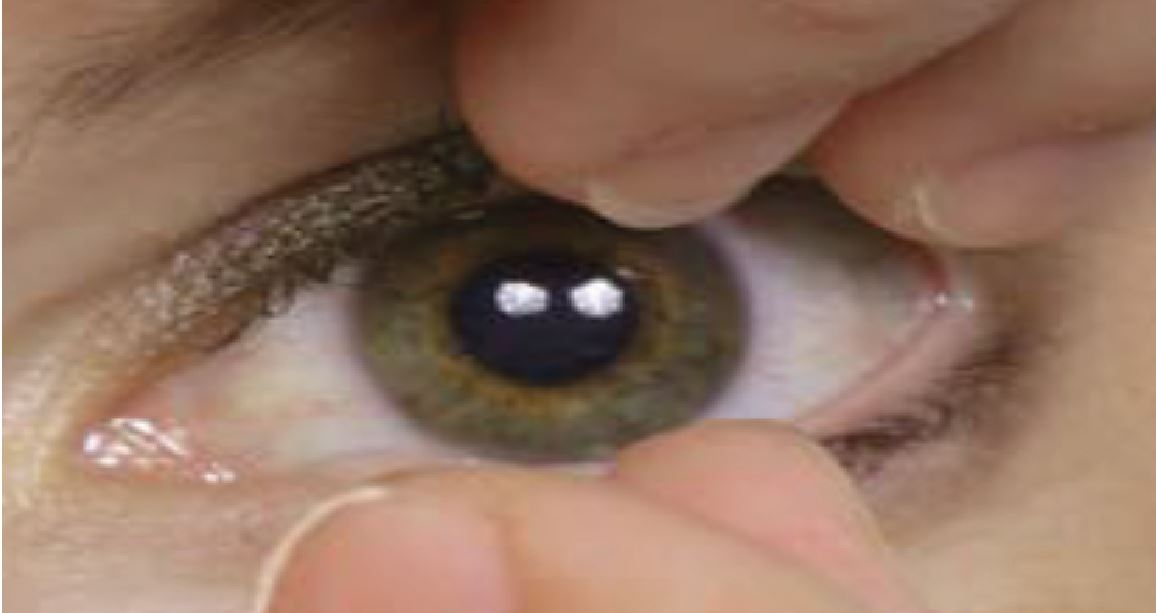
Figure 4: Removal of a hybrid lens
Both No7 and Cantor & Nissel advise against pinching their lens and prefer the alternative techniques including the ‘Eyelid’ or ‘Scissor’ method – similar to removing an RGP by trapping the lens between the lid margins. A GP lens removal tool on the soft skirt and GP junction can also be employed but should not be necessary.
Lens Care and replacement
All readily available soft lens chemical disinfection systems can be used with hybrids. The authors’ preference would be for MPS over hydrogen peroxide. RGP lens care solutions are contraindicated. Should more effective cleaning be required a soft lens daily cleaner can be used. Soft lens comfort drops can be used as necessary; ideally preservative free and instilled into the bowl of the lens before application. The recommended replacement schedule for Duette lenses is every six months.
Latest product development
All of the new generation products from SynergEyes will shortly be available with Tangible Hydra-PEG surface treatment. Hydra PEG is an FDA, and soon to be CE, approved technology developed by Tangible Science. It applies a 90% water polyethylene glycol (PEG) based polymer mixture to the front and back surface of the lens that is designed to improve wettability and surface water retention.
Discussion
Modern soft toric lenses provide many patients with good visual acuity throughout the day. However, some patients will complain that their vision fluctuates from time to time if the lens rotates off axis. In a recent study of six different soft toric lenses it was found that mean rotation ranged from 5.1 to 10.4 degrees off axis.2 This rotation is more likely to occur on patients with any combination of higher, against-the-rule or oblique cyls. Also with manufacturing tolerances and the common availability of cylinder powers in no closer than 10 degree steps, it can be seen why some patients get less than perfect visual performance, especially on higher cyls. This is not ideal and could result in cessation of lens wear.
The SynergEyes Duette range has, in particular, taken hybrids from the realms of just being a speciality lens and into mainstream contact lens practice. By offering empirical fitting like a soft lens, this hybrid is a viable alternative to soft toric lenses for moderate to high astigmats and also to soft toric multifocals for astigmatic presbyopes.
It can be theorised that hybrid multifocal lenses might deliver more consistent vision for presbyopic astigmats than the far more complex soft toric multifocal lens designs. By naturally utilising the tear lens to correct the corneal cylinder, the only visual aspect of the lens the practitioner needs to pay attention too is maximising the multifocal performance. In the event of either poor visual acuity at distance or near or both, the fitter can be confident that it can only be the progressive/multifocal design compromising vision (and thus focus on this area for adjustment/modification) and not the stabilisation and/or accuracy of the toric component, as could be the case with a soft toric multifocal.
Summary
Hybrid lenses ‘best of both worlds’ approach, combining the visual performance of a RGP lens with the comfort of a soft lens, makes them a powerful tool in the armoury of the modern contact lens fitter in regular high street contact lens practice. With some lenses utilising empirical fitting and adopting similar evaluation techniques to soft lenses, they can be easy to fit and a useful alternative to higher cyl powered soft torics, especially when combined with a progressive/multifocal design for patients who are also presbyopic. Differentiation is a buzzword these days and offering a product that solves problems for patients who may have struggled with other means of correcting their vision can only help to raise the practice and practitioners profile.
Nick Atkins is a contact lens optician and director of marketing and professional services for Positive Impact.
Phil Thompson is a contact lens optician and professional services consultant for SynergEyes UK.
References
- Trinh T, Doan OD, Ekaterina Kolozhvari MS, Rosa Lee MS, Ryan Hernandez. Evaluating the Strength of the Junction between RGP and SiHy in SynergEyes Hybrid Contact Lens. Poster, BCLA Conference, 2017.
- Kah Ooi Tan, Yu Wei Koh, Chen Siew Alison Tan, Cong Ling Teo. Evaluation of stability of lens rotation and lens wear comfort of toric soft contact lenses in Singapore. Contact Lens and Anterior Eye, Feb. 2015
